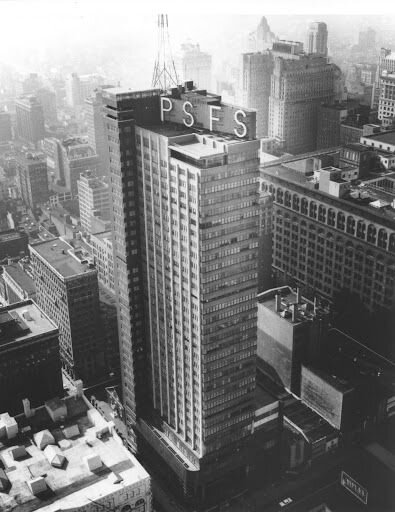The PSFS Building as a ‘Revolutionary’ Act
During the first quarter of the 20th century, architecture was very much shaped in what we perceive as our “consumable” every day. Figures like Le Corbusier emerged trying to define their epoch by self-proclaiming fosters of the old and forerunners of the new. Using the built environment of the past as a deriving agency in the process of revolutionizing the future. That progression-based revolution acted as a catalyst in the process of revealing people’s different perspectives with the same big, and sometimes ambiguous ideas, but different points of departure. For Le Corbusier it was a case of, “new problems have been posed and new equipment created to solve them.”[i] While for the sangfroid Mies, “one will have to understand that all building art arises out of its own epoch and can only manifest itself in addressing vital tasks with the means of its own time. It has never been otherwise.”[ii] Thus, the purpose of this paper is to unfold the “new” architecture of the 20th century, the international style, through the prism of two diverse originators, and the PSFS as an instigator of such ‘revolution’.
Le Corbusier is undeniably among the most repellingly fascinating “star” architects of the 20th century. He was among the first to address the new problems that had been posed and embrace the new equipment needed to solve them, transforming the simple dwelling of the house to “a machine in which to live in.” For him, “man and machine work in close collaboration; intelligence selection proceeds with an imperturbable certainty.”[iii] Lined with Corbusiers notion, for Mies, “the building art is always the spatially apprehended will of the epoch…One will have to understand that all buildings art arises out of its own epoch and can manifest itself in addressing vital tasks with the means of its own time.”[iv]
For that very reason the PSFS hold such a great significance. It is a breach between worlds, the old and the new and that breach is epitomized in things as its modernist style, which through the language of simplicity is projected in the “reduced palette of materials that possessed sharply contrasting qualities – black and white, hard and soft, opaque and transparent – qualities that were inherent to the materials themselves.”[v]
According to Le Corbusier, the first quarter of the 20th century was faced with the dilemma, Architecture or Revolution. For him, if “we were able to build, we would be enthusiastic about building, and we would avoid revolution.” Where, if we “set this renewal against the past, there is revolution.”[vi] His approach however, comes in contrast with the words he chose to contextualize it. For Corbusier, revolution is nothing more than a manipulative implementation of his dogma upon the world, were architecture is the capitalistic vision of the years to follow. His notion of architecture holding the capacity to suppress revolution is limited in the construction of block of apartments for individual sale. Thus, he is implying that with radical architecture we can not avoid revolution. And such ‘revolutionary’ qualities could be seen in the primitivism of PSFS, qualities that came in contrast with the ornament orientated architecture of the past. There then, “simplicity would seem to be the key to this wonderful building, primitivism in a number of senses. Like American skylines, city streets, and college students, it shows a savage sort of beauty.”[vii]
Its primitivism however, is not denying the building a lack of a complex design language or a shortage in delivering its programmatic provisions. The building manages to liberate itself from the constraints of the past and be “‘ultra-practical’ because it transcends itself as an accommodation of particular functions into an urban receptacle not only of these events but many, many others besides.”[viii]
The demands of the time for realism and functionality had been filled. “If that is done with generosity, then the buildings of our time will demonstrate the generosity our time is capable of, and only a fool would maintain that it is without greatness.”[ix] Both Mies and Corbusier, embraced the evolving circumstances of the world in the 20th century and adjusted their design ideas toward the implementation of a ‘new’ architecture, freed from the past and an open agency for the future and the PSFS is the implementation of just that. The revolution was not avoided rather, the fact that it “did not so much internalize the city in its accommodation of these and other events as it opened itself to the town’s structures and situations, some of which were quite stable within the cultural context, while others were emerging with the building itself.”[x] Makes the PSFS still such a prominent building in Philadelphia’s skyline until today.
[i] Le Corbusier, “Architecture or Revolution,” from Toward an Architecture (Getty, 2007 [orig. 1923), p.293.
[ii]Ludwig Mies van der Rohe, “Building Art and the Will of the Epoch” (1924), from Fritz Neumeyer, ed., The Artless Word: Mies van der Rohe on the Building Art (MIT, 1991), p.245.
[iii] Le Corbusier, “Architecture or Revolution,” from Toward an Architecture (Getty, 2007 [orig. 1923), p.295.
[iv] Ludwig Mies van der Rohe, “Building Art and the Will of the Epoch” (1924), from Fritz Neumeyer, ed., The Artless Word: Mies van der Rohe on the Building Art (MIT, 1991), p.245.
[v] David Leatherbarrow, “Practically Primitive,” in J. Odgers, ed., Primitive: original matters in architecture (London: Routledge, 2006), 130.
[vi]Le Corbusier, “Architecture or Revolution,” from Toward an Architecture (Getty, 2007 [orig. 1923), p.301.
[vii] David Leatherbarrow, “Practically Primitive,” in J. Odgers, ed., Primitive: original matters in architecture (London: Routledge, 2006), 131.
[viii] David Leatherbarrow, “Practically Primitive,” in J. Odgers, ed., Primitive: original matters in architecture (London: Routledge, 2006), 136.
[ix]Ludwig Mies van der Rohe, “Building Art and the Will of the Epoch” (1924), from Fritz Neumeyer, ed., The Artless Word: Mies van der Rohe on the Building Art (MIT, 1991), p.246.
[x] Leth138

